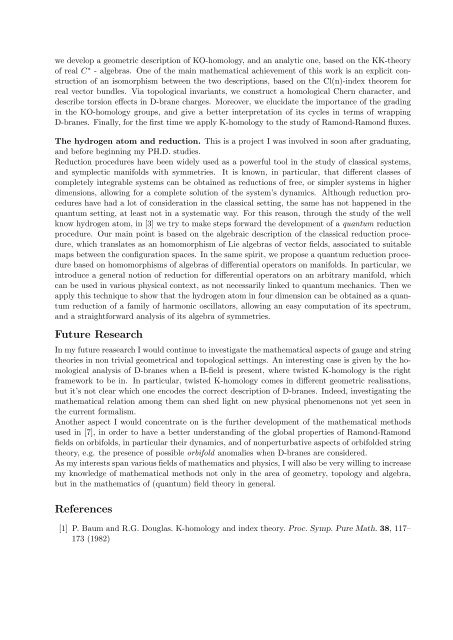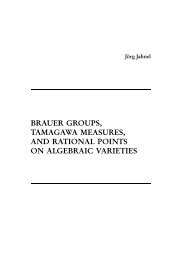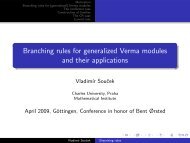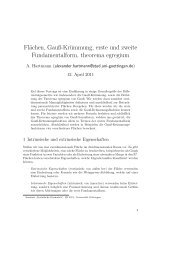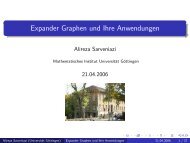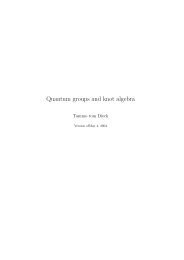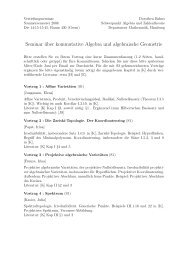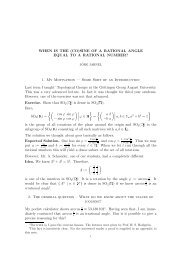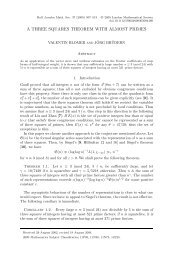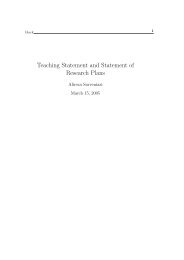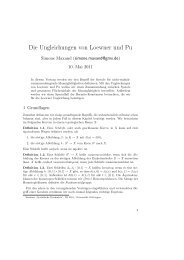Research statement (short version)
Research statement (short version)
Research statement (short version)
Create successful ePaper yourself
Turn your PDF publications into a flip-book with our unique Google optimized e-Paper software.
we develop a geometric description of KO-homology, and an analytic one, based on the KK-theory<br />
of real C ∗ - algebras. One of the main mathematical achievement of this work is an explicit construction<br />
of an isomorphism between the two descriptions, based on the Cl(n)-index theorem for<br />
real vector bundles. Via topological invariants, we construct a homological Chern character, and<br />
describe torsion effects in D-brane charges. Moreover, we elucidate the importance of the grading<br />
in the KO-homology groups, and give a better interpretation of its cycles in terms of wrapping<br />
D-branes. Finally, for the first time we apply K-homology to the study of Ramond-Ramond fluxes.<br />
The hydrogen atom and reduction. This is a project I was involved in soon after graduating,<br />
and before beginning my PH.D. studies.<br />
Reduction procedures have been widely used as a powerful tool in the study of classical systems,<br />
and symplectic manifolds with symmetries. It is known, in particular, that different classes of<br />
completely integrable systems can be obtained as reductions of free, or simpler systems in higher<br />
dimensions, allowing for a complete solution of the system’s dynamics. Although reduction procedures<br />
have had a lot of consideration in the classical setting, the same has not happened in the<br />
quantum setting, at least not in a systematic way. For this reason, through the study of the well<br />
know hydrogen atom, in [3] we try to make steps forward the development of a quantum reduction<br />
procedure. Our main point is based on the algebraic description of the classical reduction procedure,<br />
which translates as an homomorphism of Lie algebras of vector fields, associated to suitable<br />
maps between the configuration spaces. In the same spirit, we propose a quantum reduction procedure<br />
based on homomorphisms of algebras of differential operators on manifolds. In particular, we<br />
introduce a general notion of reduction for differential operators on an arbitrary manifold, which<br />
can be used in various physical context, as not necessarily linked to quantum mechanics. Then we<br />
apply this technique to show that the hydrogen atom in four dimension can be obtained as a quantum<br />
reduction of a family of harmonic oscillators, allowing an easy computation of its spectrum,<br />
and a straightforward analysis of its algebra of symmetries.<br />
Future <strong>Research</strong><br />
In my future reasearch I would continue to investigate the mathematical aspects of gauge and string<br />
theories in non trivial geometrical and topological settings. An interesting case is given by the homological<br />
analysis of D-branes when a B-field is present, where twisted K-homology is the right<br />
framework to be in. In particular, twisted K-homology comes in different geometric realisations,<br />
but it’s not clear which one encodes the correct description of D-branes. Indeed, investigating the<br />
mathematical relation among them can shed light on new physical phenomenons not yet seen in<br />
the current formalism.<br />
Another aspect I would concentrate on is the further development of the mathematical methods<br />
used in [7], in order to have a better understanding of the global properties of Ramond-Ramond<br />
fields on orbifolds, in particular their dynamics, and of nonperturbative aspects of orbifolded string<br />
theory, e.g. the presence of possible orbifold anomalies when D-branes are considered.<br />
As my interests span various fields of mathematics and physics, I will also be very willing to increase<br />
my knowledge of mathematical methods not only in the area of geometry, topology and algebra,<br />
but in the mathematics of (quantum) field theory in general.<br />
References<br />
[1] P. Baum and R.G. Douglas. K-homology and index theory. Proc. Symp. Pure Math. 38, 117–<br />
173 (1982)


